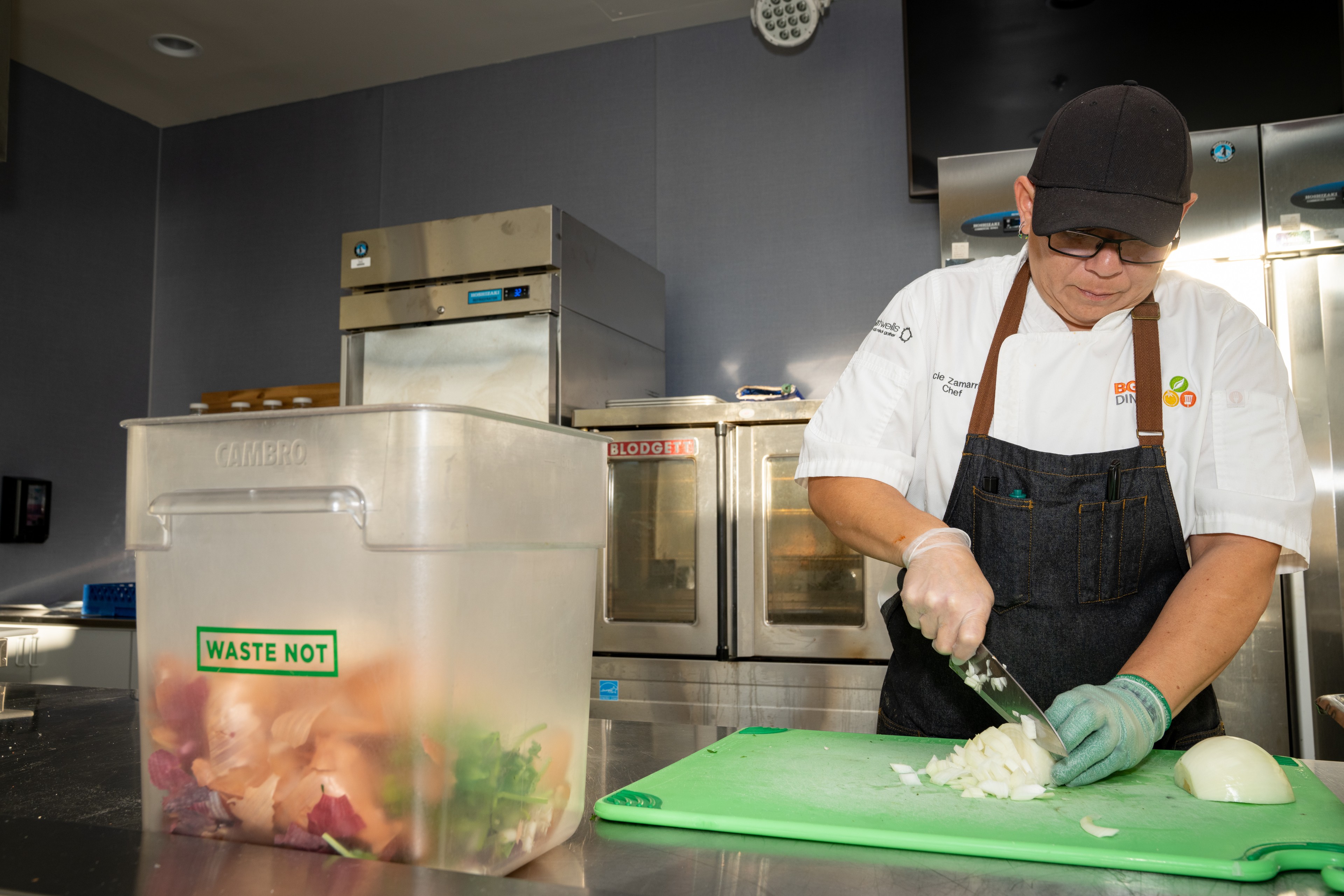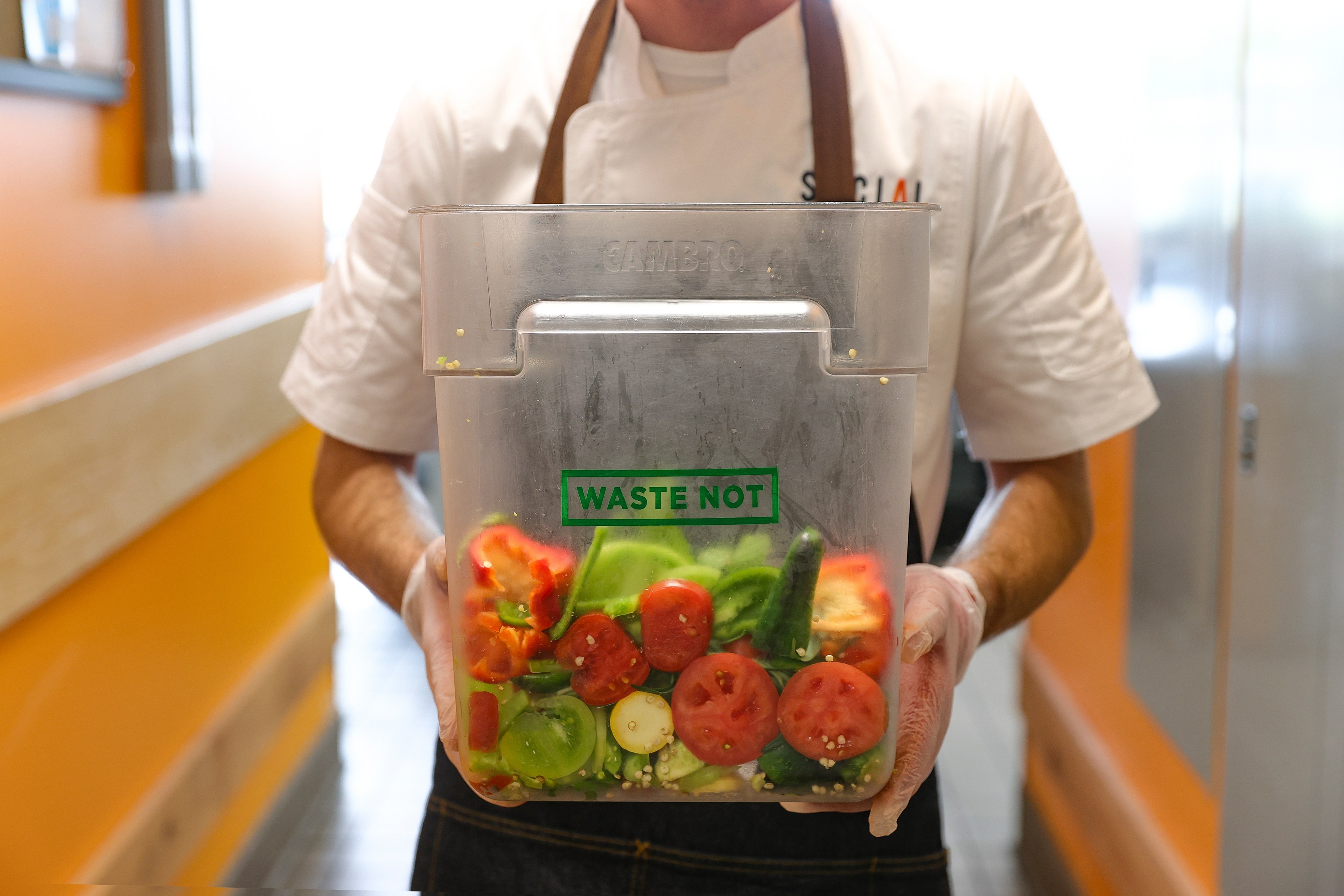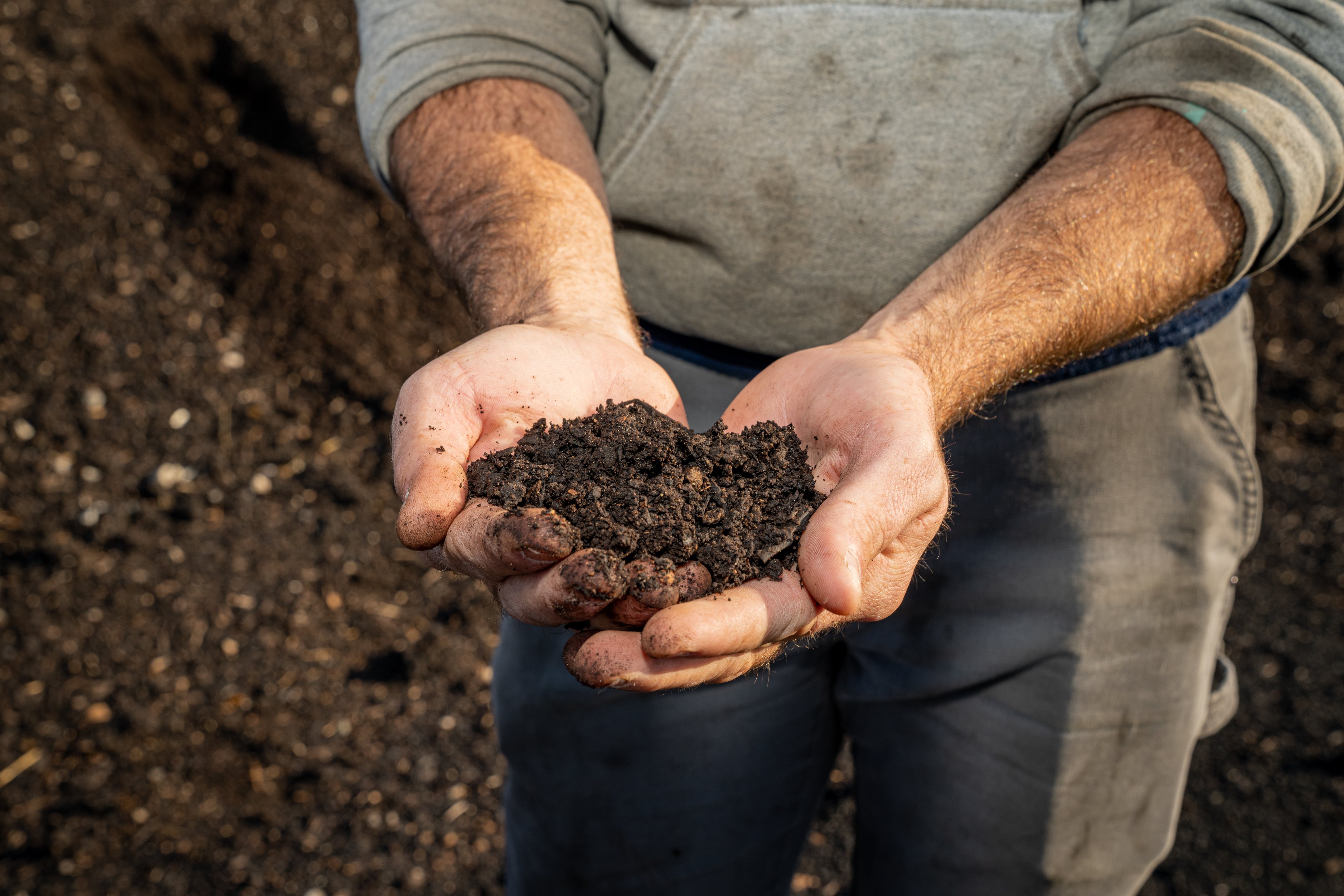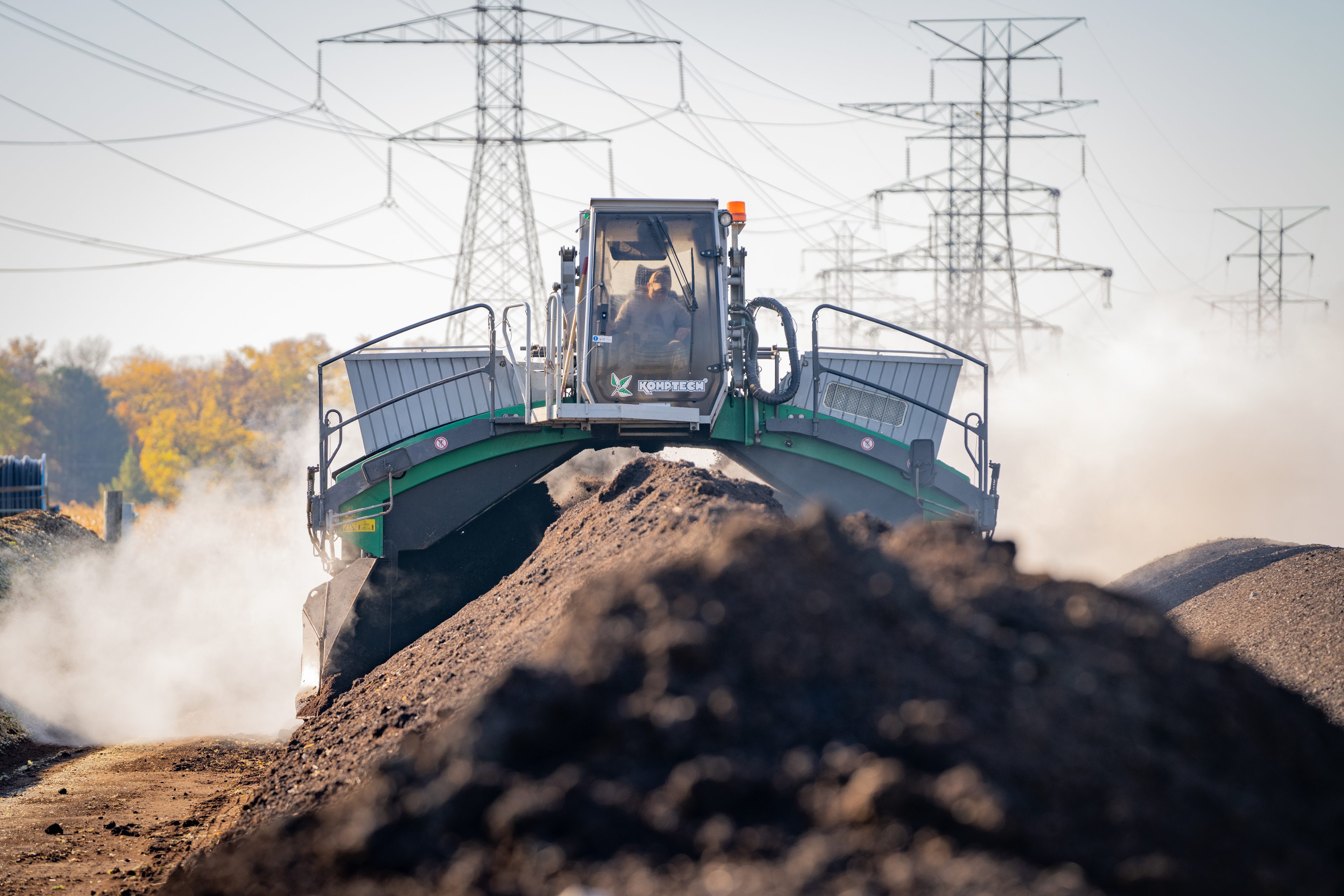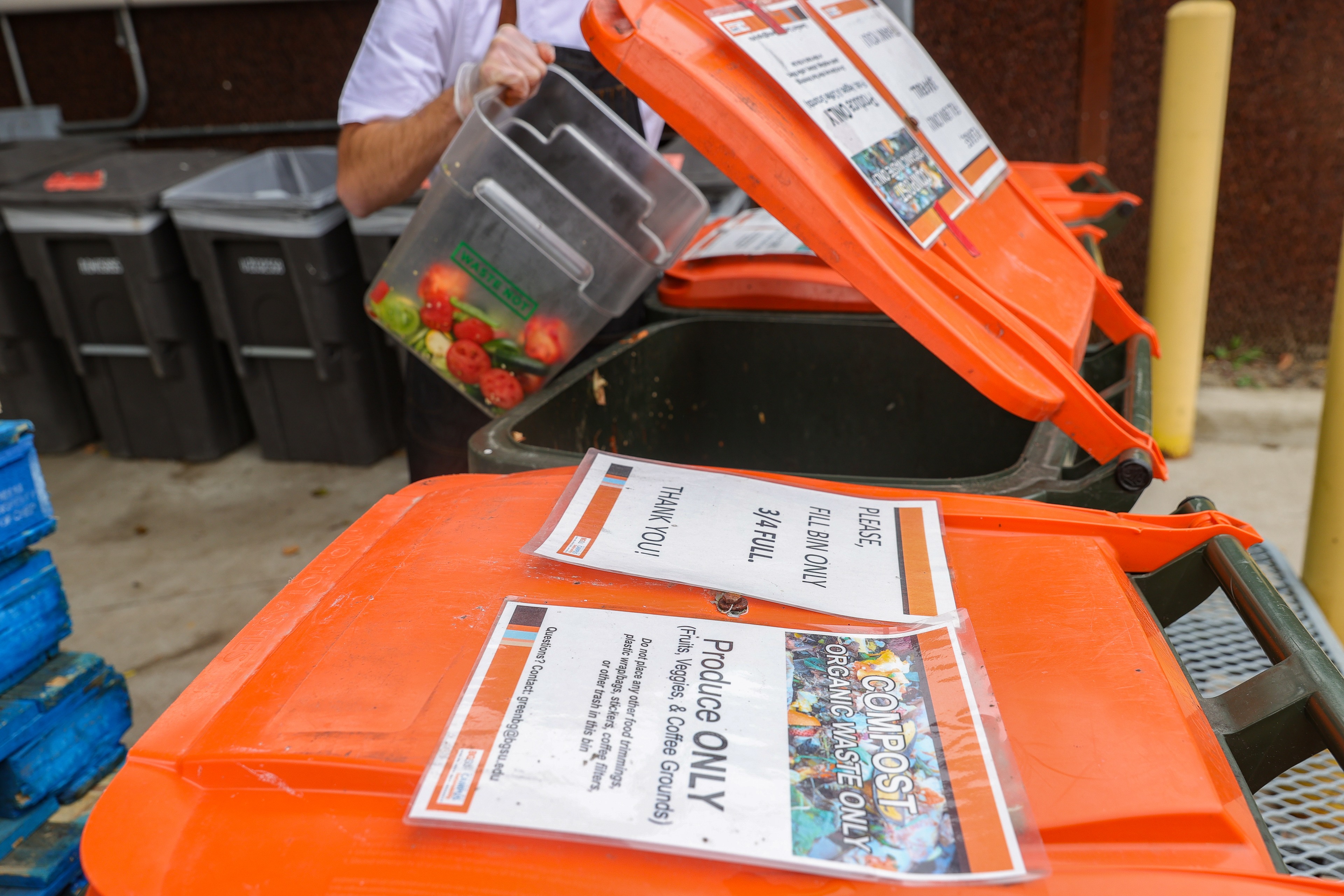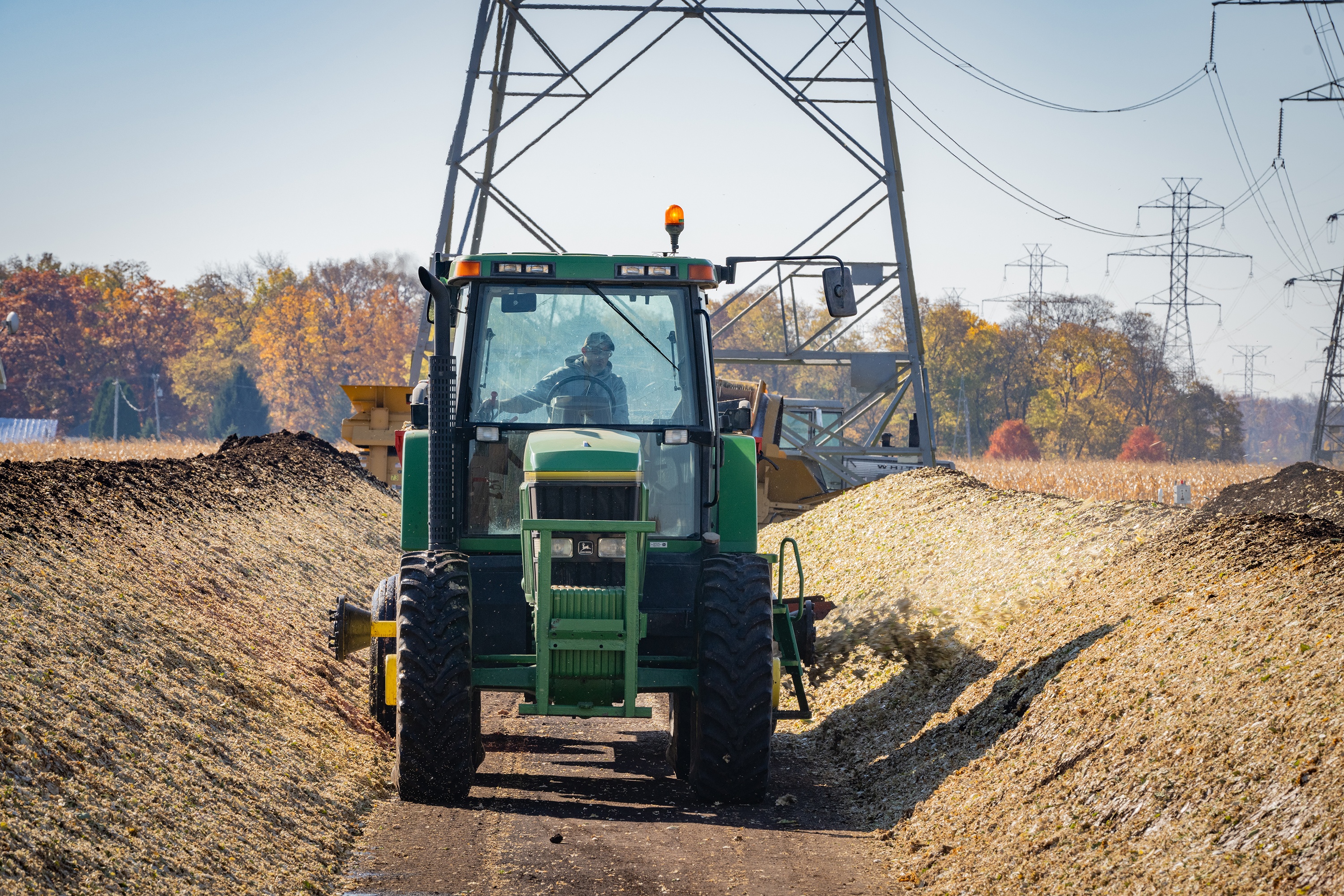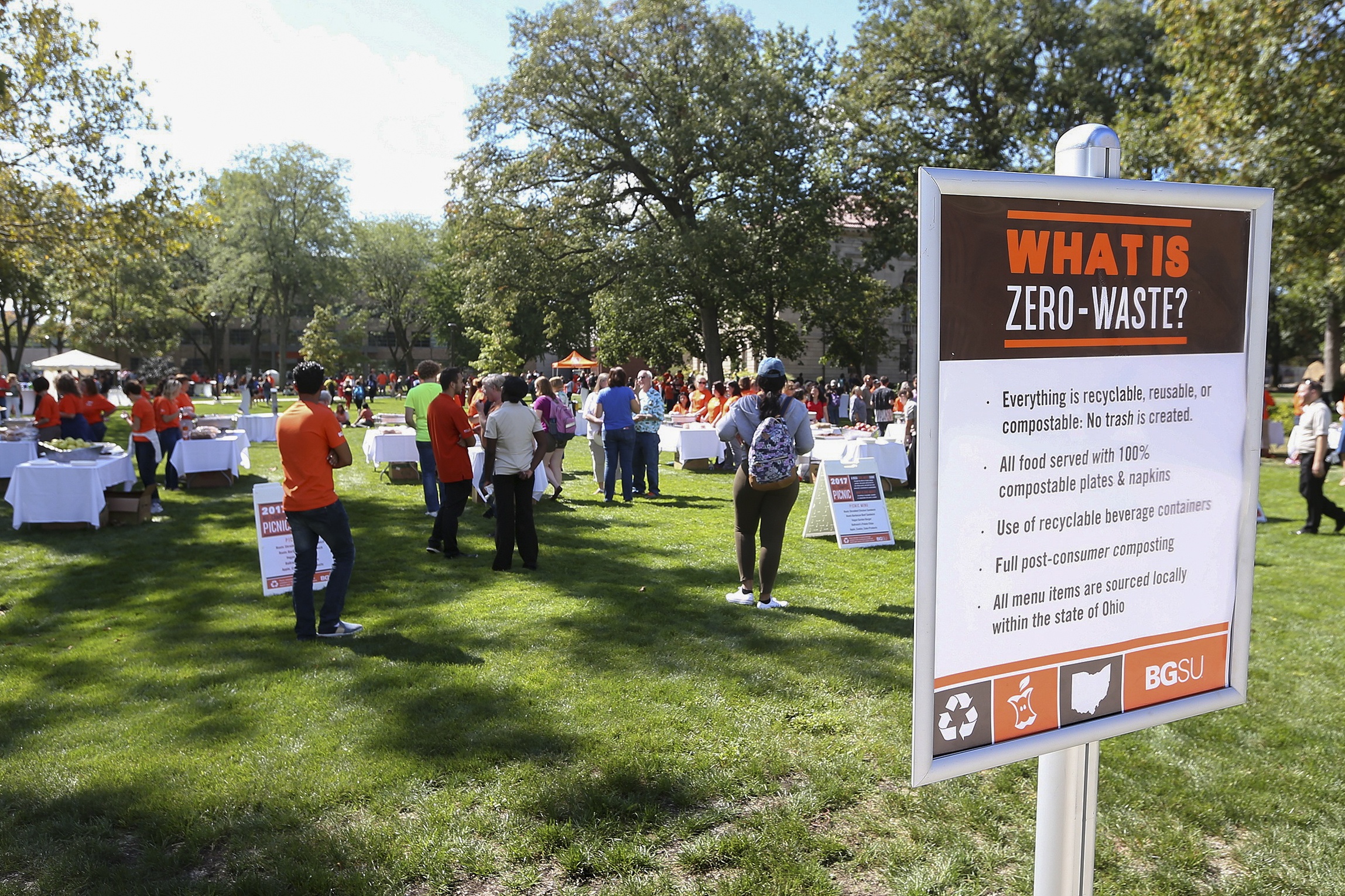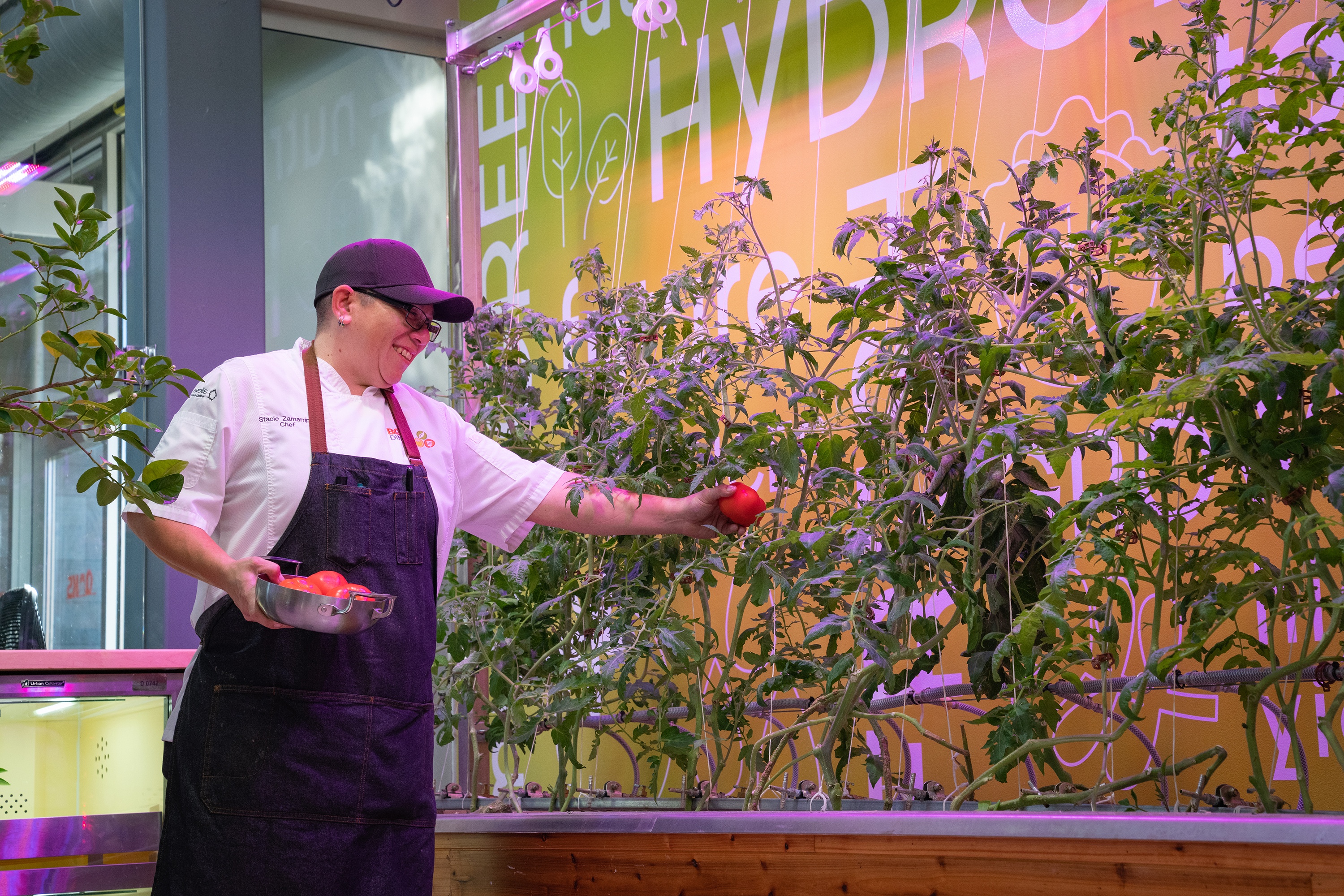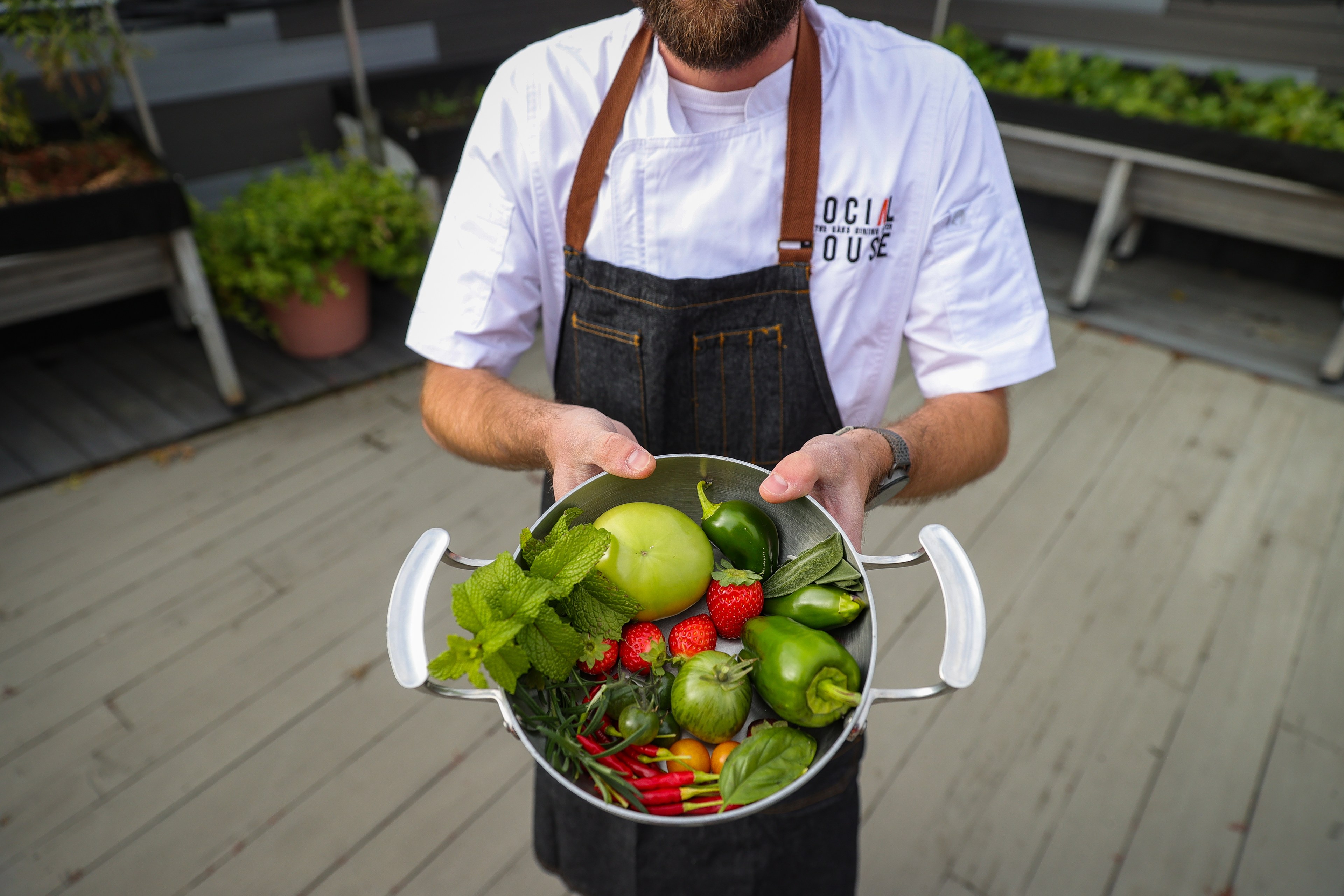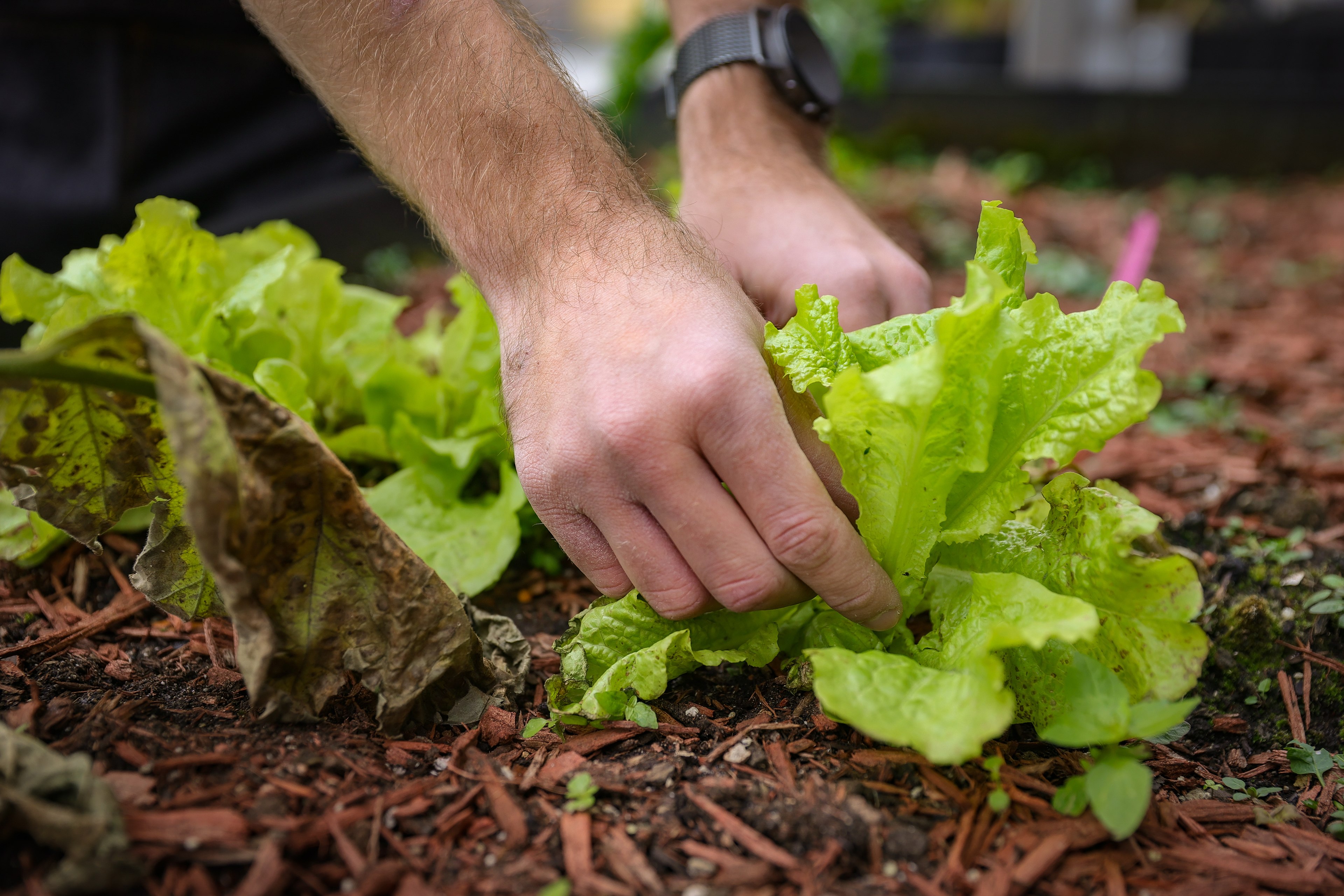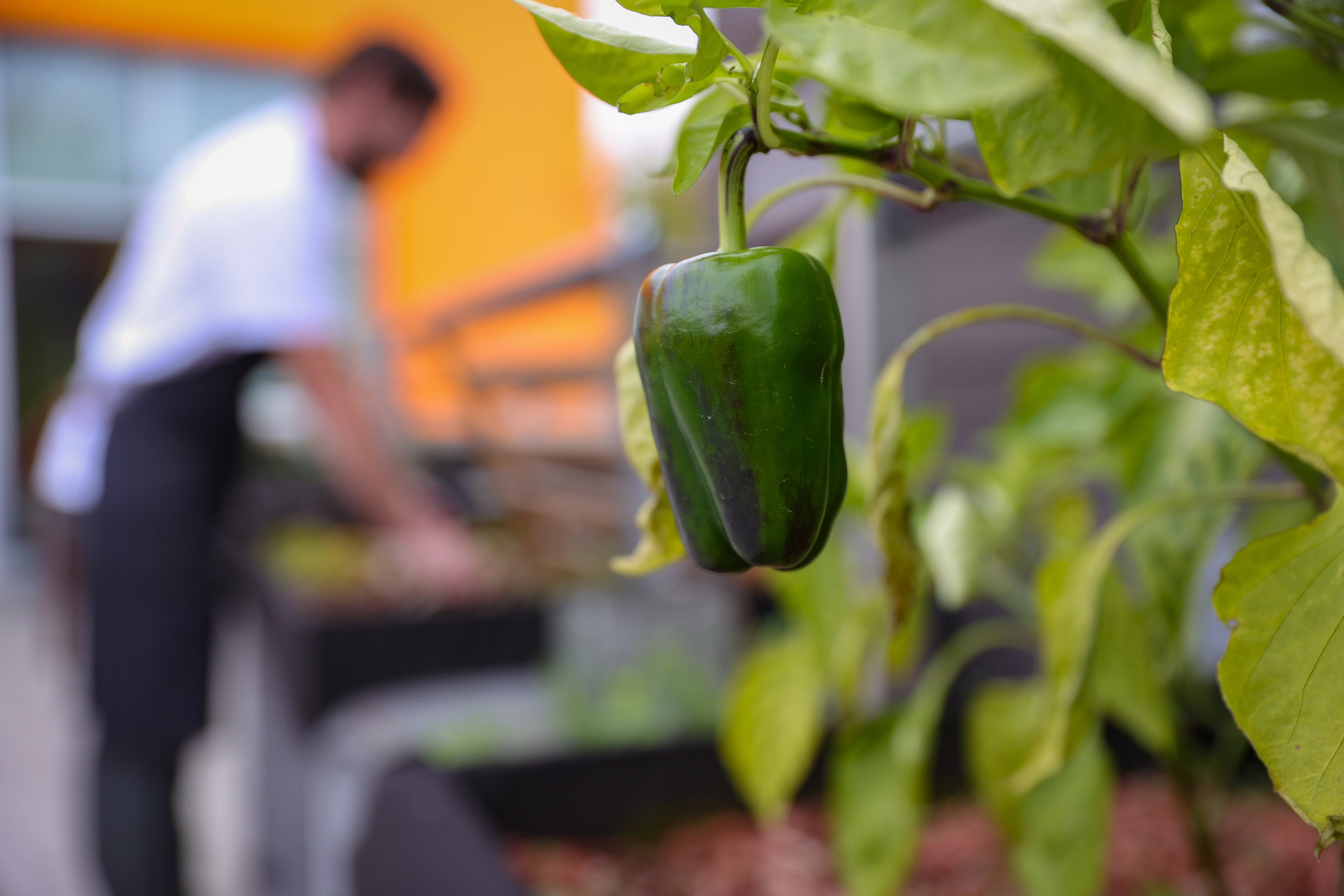Advancing Our Impact

From Dining to Dirt
BGSU composting program diverts food waste from landfills, decreasing carbon emissions and aiding in the fight against global climate change
Story by: Laren Kowalczyk | Design by: Josie Jonckheere | Photos and video by: Craig J. Bell, Justin Camuso-Stall and Haven Conn
Recognized nationally as an environmentally responsible university, BGSU keeps more than a thousand pounds of food waste out of landfills each week through its composting program partnership.
SustainabilitySustainability efforts are typically easy to spot, from recycling bins dotting the Bowling Green State University campus to motion-sensor lights in classrooms and offices.
Water bottle refilling stations, solar panels on roofs and reusable bags also signal the University's commitment to the environment.
Along with visible nods to waste reduction and energy conservation exists a lesser-known initiative profoundly reducing the University’s carbon footprint and aiding in the fight against global climate change.
Every week, BGSU diverts an average of more than 1,400 pounds of pre-consumer food waste from landfills through a composting program partnership with Hirzel Farms in nearby Pemberville, Ohio.
“Sending food waste to a landfill is a very heinous thing,” said Dr. Nick Hennessy, sustainability manager in the BGSU Office of Campus Sustainability. “Food waste in landfills produces methane, which is more injurious to the environment than carbon dioxide and other greenhouse gasses.”
The University’s commitment to sustainability encompasses numerous initiatives beyond dining, but its food waste diversion and reduction programs considerably impact the institution’s carbon footprint. BGSU is on target with its goal to reduce its greenhouse gas emissions annually by an average of 4% to achieve institutional carbon neutrality by 2040, as outlined in its Climate Action Plan.
Its efforts also score high marks in the annual Princeton Review Guide to Green Colleges rankings with the University scoring a 99 out of 99 in the 2023 rankings. BGSU also earned a spot in the review's 2023 Green College Honor Roll rankings as the only university in Ohio among 31 nationwide.
And in the 2023 nationwide Campus Race to Zero Waste competition, BGSU received second place among medium-sized campuses for its achievements in the handling of food organics. The Food Organics category recognizes campuses that successfully implement food waste minimization activities that address overage, including portion-control techniques and preparing food to order. The competition also took into account how recovered food waste is managed by campuses.
BGSU has been listed among the nation’s most environmentally responsible colleges for 10 years.
“Being recognized by the Princeton Guide is always an honor and is one of the many things that reaffirms the work we're committed to at BGSU is helping to fulfill our mission of creating public good," Hennessy said. “The need to prioritize sustainability across our campus continues to be important as the reduction of carbon emissions and lessening the effects of climate change become increasingly critical."
Food waste in landfills
Food waste is often left out of conversations about sustainability, explained Dr. Enrique Gomezdelcampo, associate professor in the School of Earth, Environment and Society in the College of Arts and Sciences at BGSU.
But according to the U.S. Environmental Protection Agency, food waste is the largest category of material in landfills in the United States, accounting for 24% of landfilled municipal solid waste.
“We learn about recycling in kindergarten,” Gomezdelcampo said. “People recycle and think they’ve done their part for the environment. They feel good about it.”
But the reality is, he said, recycling inorganic materials like glass, cardboard and paper is only one part of the sustainability equation.
As food scraps decompose in landfills, methane is produced and released into the atmosphere.
The EPA reports that methane is up to 36 times more effective at trapping heat in the Earth’s atmosphere than carbon dioxide over 100 years, and landfills are the third-largest source of human-caused methane emissions in the U.S.
“Landfills are a significant source of methane,” Gomezdelcampo said. “When you take organic material out of the waste stream and minimize methane generation, that’s beneficial to the environment.”
BGSU has saved nearly 330,000 pounds - or 150 metric tons - of food waste from landfills since it began composting eight years ago through a pilot program that's funded and supported by the Student Green Initiatives Fund. The Green Fund - a pool of money available from an opt-out fee per semester - continues to fund the initiative annually as well as other sustainability projects across campus.
In partnership with BGSU Dining by Chartwells Higher Education, the program began at The Oaks dining center and expanded to include the Falcon’s Nest inside the Bowen-Thompson Student Union and Carillon Place.
Pre-consumer food waste is picked up twice weekly from all three locations during the fall and spring semesters and transported to Hirzel Farms, which uses most of the compost for its farming operations and sells a small portion to local nurseries, landscapers and farmers markets.
Having the right partnerships is crucial to our efforts and there is no better partner to have than BGSU.
-Mike Chandler '15
Mike Chandler, a 2015 graduate of BGSU with a degree in geology, is the compost facility supervisor at Hirzel Farms. Part of his job involves spreading and mixing food waste from the University and other sources into the existing compost, which helps speed up the process and provides richer soil. The farm produces between 8,000 and 10,000 tons of compost yearly, which would cover the equivalent of 10 football fields an inch deep.
“As a science major, I’m someone who believes strongly in the benefit that the environment provides to all of us,” Chandler said. “I think it’s incredibly important to be aware of that and be active in making a change and a difference in the world around us.
“What we do is relatively small in the grand scheme of things, but we are making an impact and we can’t do it alone. Having the right partnerships is crucial to our efforts and there is no better partner to have than BGSU.”
Skipping the trash
Along with waste diversion, there’s also a commitment to reduce food waste overall at the University.
Dining staff at all three facilities are trained to maximize the use of produce during food prep and consider additional uses before sending peels, rinds and stems to be composted.
For example, the scraps from cleaning carrots, celery, onions and tomatoes are used to make vegetable broth. The broth is then used as a base in various sauces, explained Eric Yung, senior executive chef and director of culinary operations at BGSU. The process not only reduces food waste but offers financial benefits as well.
Culinary staff also communicate daily and share ingredients among facilities.
Additionally, the University implemented trayless dining in all its facilities beginning in 2014, which is proven to reduce the amount of food people take and then throw out.
There is also intentionality in the size of plates, bowls and cups available at the dining facilities.
“If you give someone a 15-ounce bowl, they’re most likely going to fill it with 15 ounces of food whether or not they want it,” Yung said. “The smaller bowls and plates don’t stop a student from going back and getting a second helping if that’s what they want, but it does help reduce the amount of food thrown in the trash.”
Zero-waste picnics are another example of the University’s commitment to protecting the environment. Each item on the menu is carefully vetted for its potential to create waste.
The Convocation picnic this fall included barbecue chicken sandwiches, apples and corn on the cob served on compostable plates and produced one small bag of negligible waste, Yung said.
“We have pretty extensive discussions on menu items for those picnics,” Yung said. “We carefully engineer the menu to ensure the least amount of waste possible. For example, a hamburger requires condiments that a barbecue chicken sandwich does not. We also chose sides that didn’t require silverware to reduce waste further.”
Environmentally friendly inside and out
The Oaks and Carillon Place were built sustainably, a foundational objective within the University’s strategic plan to create public good. As part of that objective, sustainability efforts are built into a master plan for facilities on the Bowling Green campus and at BGSU Firelands.
The two dining facilities are among 13 LEED-certified buildings on campus. LEED - or Leadership in Energy and Environmental Design - is the global standard of sustainability. Hennessy said it’s unique to have LEED-certified dining facilities, and the accomplishment is another example of the proven commitment at BGSU to sustainability.
“Historically, when you have large dining facilities, sustainability is not the top priority,” he said. “But in our case, it was important that we set an example of sustainability in the design and construction phases and then carried that through daily operations.”
Both facilities feature glass for natural light, a thermal comfort design that stabilizes the atmosphere inside, flooring made from recycled products and stormwater reclamation systems, among other eco-friendly attributes.
Solar panels adorn the roof of The Oaks as does a green roof with a vegetable and herb garden. The green roof includes space for dining or relaxing and benefits the environment through urban heat island mitigation, reduced stormwater runoff, indoor energy savings and a longer roof life.
The LEED Gold-certified facility also uses electric catering vehicles and has a hydroponics system inside to grow vegetables and herbs for use at Rooted, which provides vegan and vegetarian meal options in Social House at The Oaks.
Materials used in the construction of the Carillon Place included low-emitting sealants, adhesives, paints and floorings. Additionally, 20% of construction materials used were obtained locally and 50% of construction waste was recycled. The LEED Silver-certified facility optimizes energy use and has reduced water consumption by 30%.
Carillon Place also recently introduced reusable carry-out containers to reduce disposable products. Students can take their food to go in an OZZI container and then swap it out for a new one through the container collection machine. The system was purchased through the Student Green Initiatives Fund.
“When you have facilities that are LEED-certified, we have a responsibility to continue that culture of sustainability in our daily food operations,” said Richard Roldan, director of BGSU Dining Services. “Sustainability is at the forefront of everything we do. It’s ingrained in our culture and we’re constantly looking at ways to reduce our environmental impact, whether through waste diversion or waste reduction.”
Updated: 05/17/2023 03:09PM


